- Joined
- Nov 10, 2019
- Messages
- 469
- Points
- 373

 |
As a way to introduce our brass coins to the community, we will raffle off a free coin during the month of August. Follow link ABOVE for instructions for entering. |
 |
 |
The beloved Ships in Scale Magazine is back and charting a new course for 2026! Discover new skills, new techniques, and new inspirations in every issue. NOTE THAT OUR FIRST ISSUE WILL BE JAN/FEB 2026 |
 |


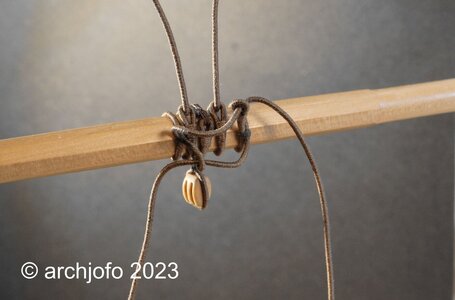
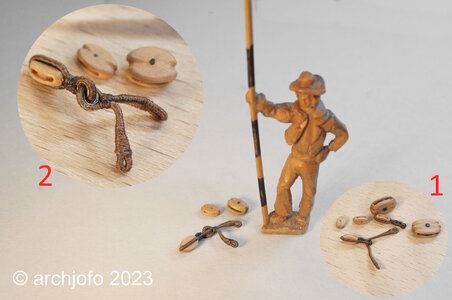
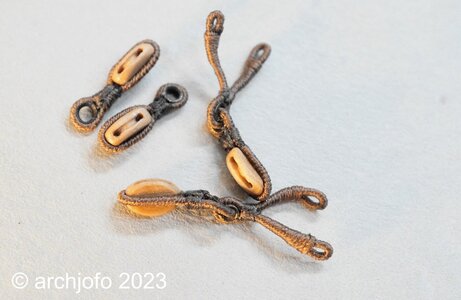
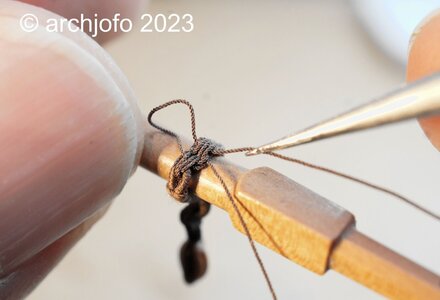
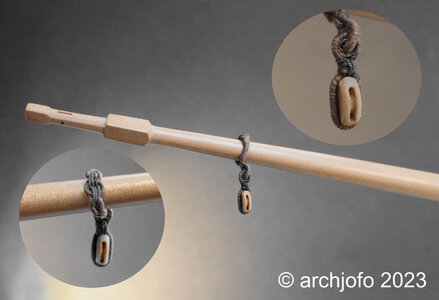

Are you sure you don't want to make sails?Equipment of the mizzen yard– truss pendant and brace blocks/ Drosse d´une basse vergue et poulies du bras de artimon
The mizzen yard is also attached to the mast with a truss pendant, analogous to the fore yard and main yard. The diameter of the ropes are of course much smaller.
View attachment 387786
Of course, the braces for the mizzen yard can only be moved forward. The standing parts were fixed to the aft shrouds of the main mast. Through another block, which was also attached to the shrouds, they ran down to the docking stations on deck. Because of the backstays of the mainmast, the blocks of the braces on the mizzen yard had to be placed closer to the middle of the yard.
On the following picture collage, picture 1 shows the blocks of the braces (l = 4.0 mm), partially strapped, for the mizzen yard. To do this, I placed two sheet blocks of the main yard to enable a size comparison. Image 2 shows a fully strapped block of the braces and another unstraped one compared to a brace block of the fore yard.
My little sailor, which I've been neglecting a bit lately, is supposed to give you a feeling for the scale of the block sizes.
View attachment 387787
The next picture shows the finished blocks for the braces. On the one hand, which are installed directly on the yard, and on the other hand the deflection blocks, which are attached to the rear shrouds of the mainmast.
View attachment 387788
As I read in C. Burney's The Boy's Manual of Seamanship and Gunnery, 1867, rose lashing was the standard connection of strops around yards and masts. Therefore, a rose lashing makes sense to me here.
View attachment 387789
Finally, there is a picture with a brace block already installed.
View attachment 387790
Soon we will continue with the foot ropes for this yard.
Or were foot ropes necessary in this case?
Sequel follows …


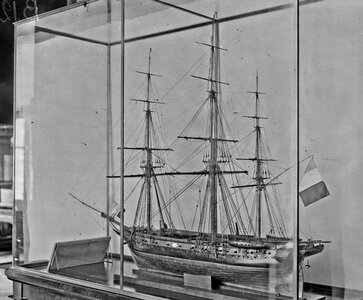
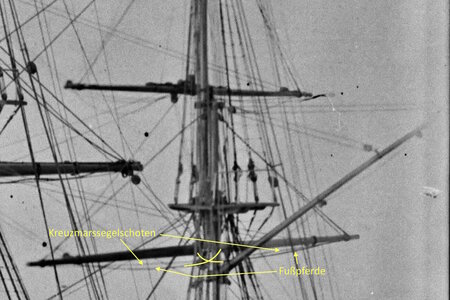
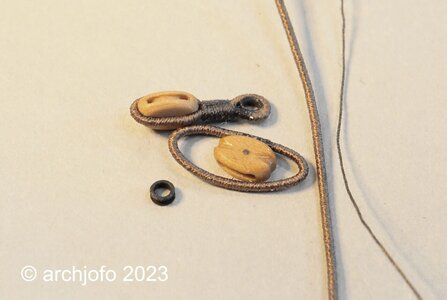
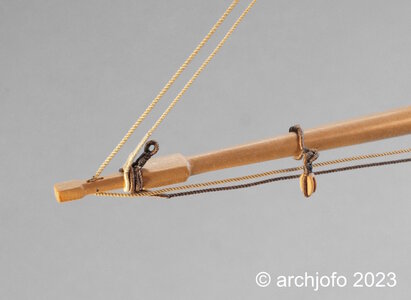
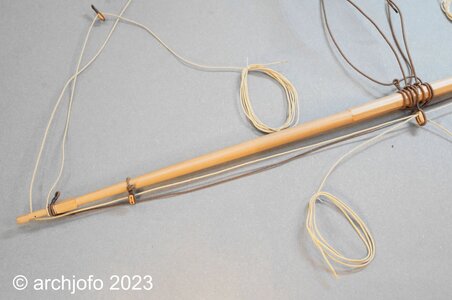
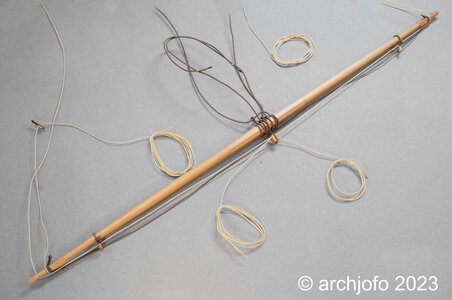

Dear Johann, every time you manage to make me amazed and speechless by your magnificent work in detail and precision!!!Completion: Equipment of the mizzen yard - footroopes, mizzen topsail sheets, lifts etc. / Marchepieds, ècoutes de perroquet de fougue, balancines etc.
Based on an older photo of the Paris model of the La Créole, I was able to trace the execution of the footropes for the mizzen yard as far as possible (see picture detail).
View attachment 388939
Source: Gallica, Bibliothèque nationale de France, Corvette La Créole [modèle réduit de bateau exposé au musée de la Marine, au Louvre] : [photographie de presse] / [Agence Rol] 1904-1908
View attachment 388938
Source: Gallica, Bibliothèque nationale de France, Corvette La Créole [modèle réduit de bateau exposé au musée de la Marine, au Louvre] : [photographie de presse] / [Agence Rol] 1904-1908 - detail of picture
The corresponding size of the mizzen yard of a corvette obviously did not require stirrups in the footropes, as can be seen in the above image detail. In this respect, I based the execution of my model on this specification.
In front of the footropes, the grommets, the strops with thimble and finally the lifts were attached to the yardarms of the mizzen yard of the model.
The next picture shows details of the 4 mm long blocks of the lifts, which will later be attached to the top of the mizzen mast on corresponding eyebolts.
View attachment 388934
The next picture shows a yardarm with the previously mentioned rigging elements and the already retracted mizzen topsail sheets.
View attachment 388935
And finally two more pictures of the finished rigged mizzen yard:
View attachment 388937
View attachment 388936
See you soon ...


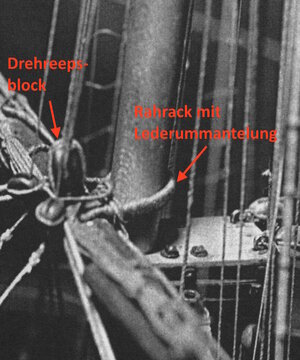
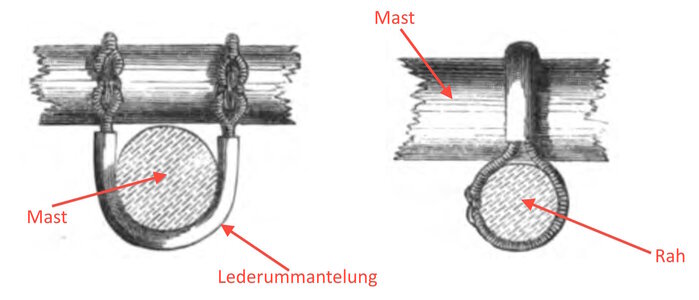
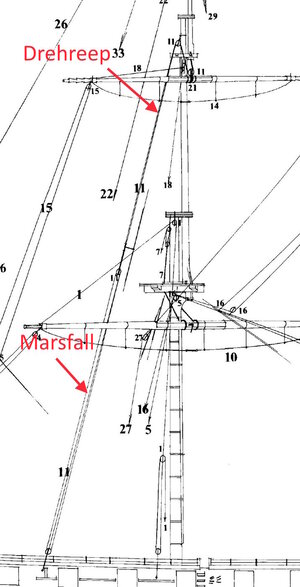
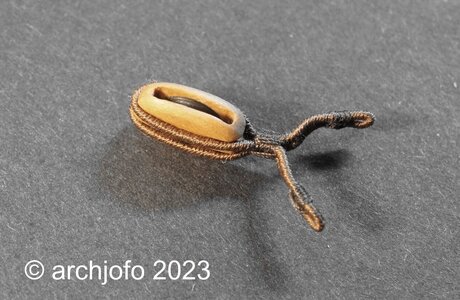
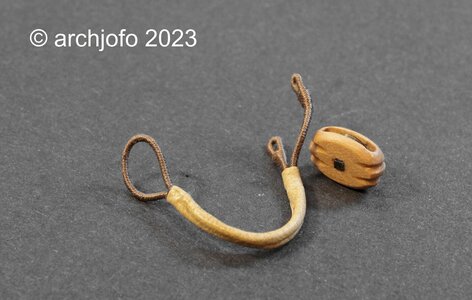
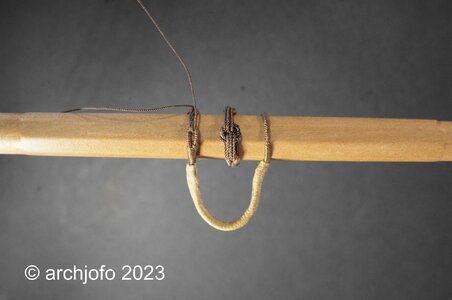
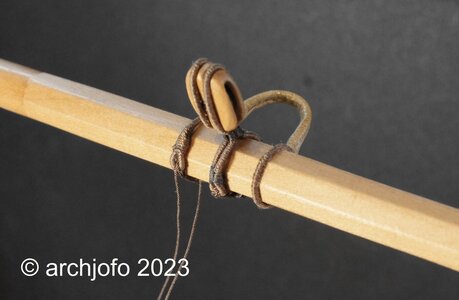
 .
.Very good question - and how you can fix it to the rope, that it is so close to the ropeWhat did you use for the leather sheathing?

I'm speechlessEquipment of the Topsail yards - topsail yard parral and topsail yard tye / Racage d´une vergue et poulie d´itague
The rigging of the topsail yard differs from the lower yards in particular in the following peculiarities:
Reef tackles, parrals and tyes with halyards.
The parrels of the topsail yards had the task of holding the yard firmly to the topmast, but at the same time there had to be enough play to allow the yard to catch sharply. In addition, the parrel should ensure that the yard can slide up and down the spar. The parrals of the topsail yards were less complex than those of the lower yards and therefore not adjustable.
When the La Créole was fitted out, parrals with ribs and trucks gradually went out of fashion. As already mentioned several times, this corvette already had many "modern" equipment elements, not only in the rigging.
According to the description in the monograph by J. Boudriot in connection with the following image section from the original Paris model, it is clearly expressed that this was a pure parral, without ribs and trucks. The rear area around the topmast was protected against wear and tear with a leather cover.
View attachment 390763
Source: Monograph La Créole by Jean Boudriot, page 169
I derived the further detailed design for my model as shown below from Seamanship by G. S. Nares, with the difference that a closed eye was formed on one side. This is evident from the description in the monograph.
View attachment 390762
Source: Seamanship, G.S. Nares, 1868
This corvette passed double tyes for hoisting and easing topsail yards. The tye blocks at La Créole were three large blocks. The tye then goes through the one block in the middle of the yard and through each of the blocks placed under the cross trees of the topmast head.
At the end of the tyes, the blocks of the halyards were integrated, which were fixed to the channels.
View attachment 390760
Source: La Créole monograph by Jean Boudriot
The following pictures show the implementation of this rigging element for the main topsail yard:
View attachment 390764
View attachment 390765
View attachment 390766
View attachment 390767
For the further rigging of the main topsail yard I still have to clarify various details, such as B. reef tackles, jackstays, blocks for sheets, clew lines, bunt lines and leech lines.
Sequel follows …




